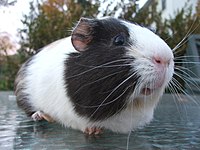
Photo from wikipedia
Butana is one of the local dairy cattle breeds of Sudan commonly kept by smallholder producers. This breed has been strongly promoted to advance the dairy production sector in the… Click to show full abstract
Butana is one of the local dairy cattle breeds of Sudan commonly kept by smallholder producers. This breed has been strongly promoted to advance the dairy production sector in the country. The main problem, however, is the lack of a systematic breeding program that involves smallholder producers. The aim of the current study was to identify the most promising design for a breeding program to improve the milk yield performance of Butana cattle under smallholder production conditions. In total, 3 breeding scenarios, including (1) the use of farm bulls, (2) the use of village bulls, and (3) the rotational use of village bulls within village groups, were simulated using a stochastic simulation approach. For each breeding scenario, 3 selection methods for bulls were considered, namely random mating, phenotypic selection, and selection based on estimated breeding value (EBV). The results showed that no genetic gain was realized with random mating in all breeding scenarios. In the farm bull breeding scenario, annual genetic gain (standard deviation units) ranged from 0.01 to 0.19 (phenotypic selection) and from 0.01 to 0.39 (selection based on EBV). In the village bull breeding scenarios, the annual genetic gain ranged from 0.01 to 0.21 (phenotypic selection) and 0.01 to 0.45 (selection based on EBV). The lowest genetic gain was realized for the rotational use of village bulls among villages within groups. Through the rotational use of village bulls, however, a higher genetic variance was maintained than in the farm and village bull breeding scenarios. We concluded that a village bull breeding program with selection based on EBV of young bulls was the most promising breeding design for achieving the breeding goal. Further studies are needed to assess the organizational feasibility of such a breeding program to ensure the participation of smallholder producers and its sustainability.
Journal Title: Journal of dairy science
Year Published: 2022
Link to full text (if available)
Share on Social Media: Sign Up to like & get
recommendations!